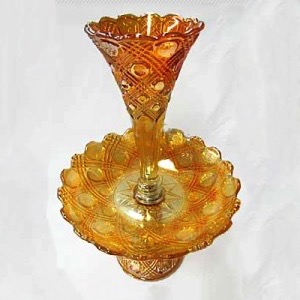Tartan, Brockwitz




Year(s) of Production: [infobar select=”DISTINCT yearofmanufacture” mfg=”Brockwitz” pattern=”Tartan”]
Pattern Description: [infobar select=”DISTINCT patterndescription” mfg=”Brockwitz” pattern=”Tartan”]
Similar Patterns: [infobar select=”DISTINCT similarpatterns” mfg=”Brockwitz” pattern=”Tartan” order=”shape”]
Sometimes Tartan has been called Daisy and Cane, and the theme is one of double serrated lines creating diamond shapes that contain 8-sided buttons. There are a few variations for the content of the ‘buttons’: some have alternating flowers (Daisies) and file pattern (cane), some have smooth buttons, and there is a report of one with all having the file pattern. In a 1921 catalog there is shown the “daisy and cane” variation, while in the 1928 catalog there is shown the plain button variation. It is possible the molds were retooled or that the company actually had multiple molds made over a long period of production. The large spittoon that was actually probably intended to be a flower/rose bowl (measuring 7” wide and 4” tall) is the only shape at this time that can be found in both marigold and blue. The small cylindrical pitcher measures approx. 7 3/4″ in height. The celery has a pedestal base. There are two sizes of vase, one cylinder shaped at 13″ high and the other one is trumpet shaped at 9″-9 1/2″ tall. The single epergne consists of 3 pieces: the base, the plate (for the fruit) and the horn (for the flowers). It is reported in two sizes 13″ and 15″ tall, the plate for the epergne measures about 10″. The bowls found in this pattern are larger, 9-11″ and have various edges, can be round or oval shaped, and are plain inside; they can be found with 3 feet and all have a squared off scalloped top. There are salvers (stemmed cake tray), butter dishes & tumble-ups with an under plate. It was obviously made in a marvelous array of shapes.
HoC Pricing Database
Select a shape below (available colors will display)
